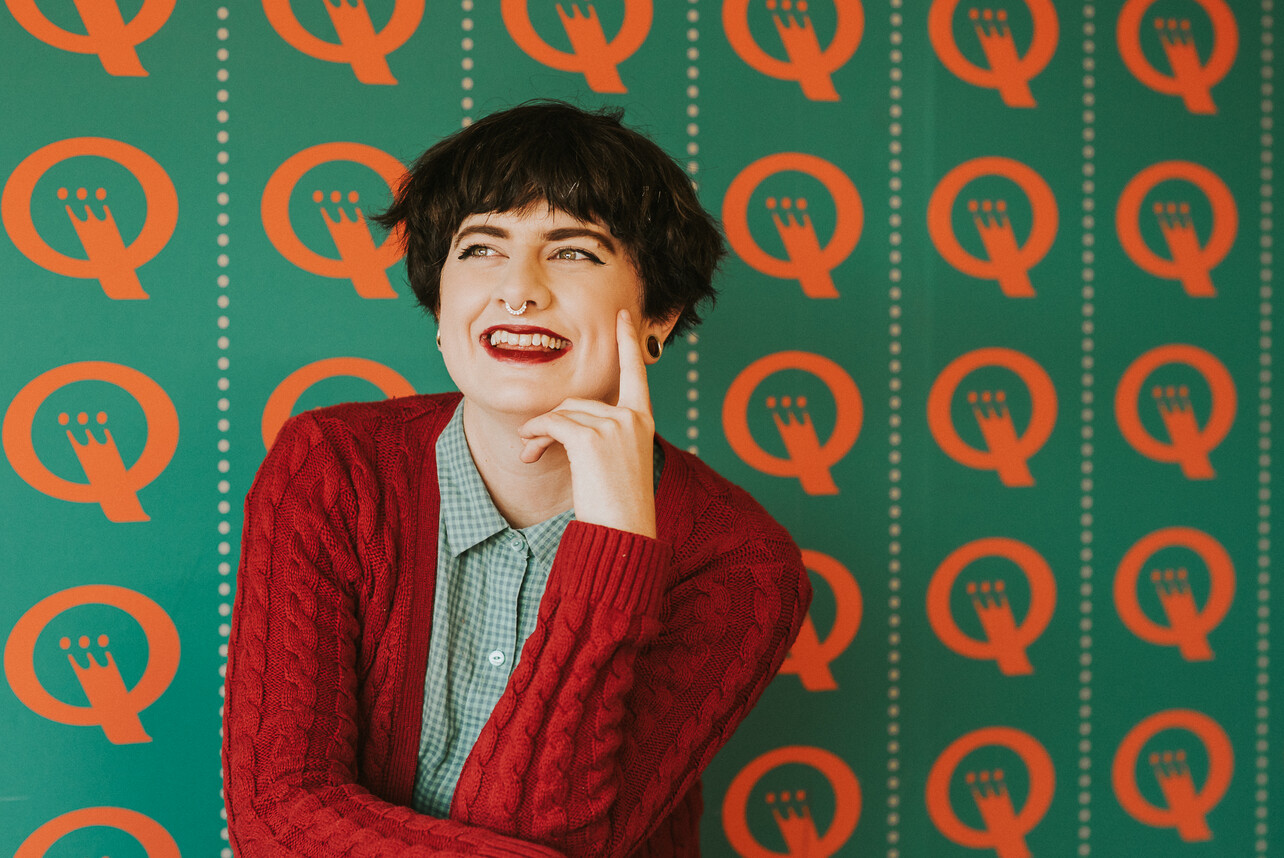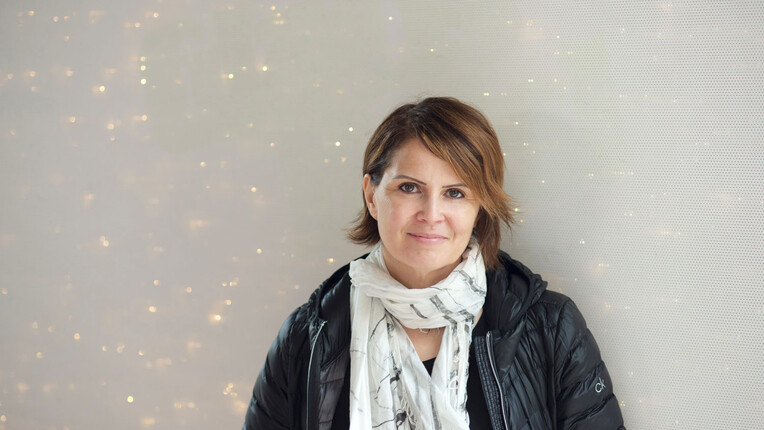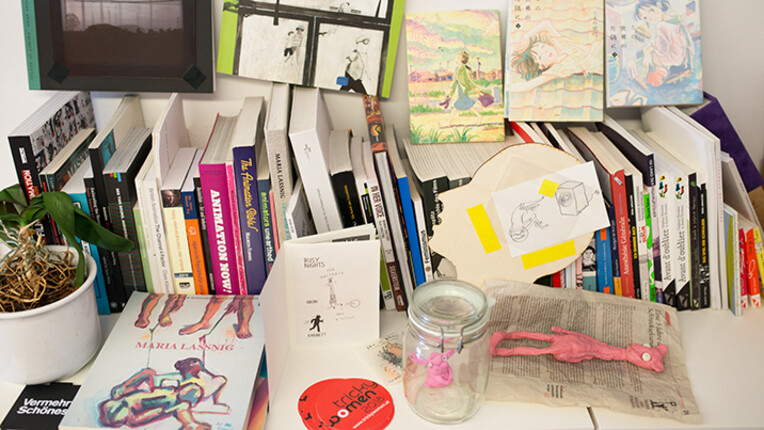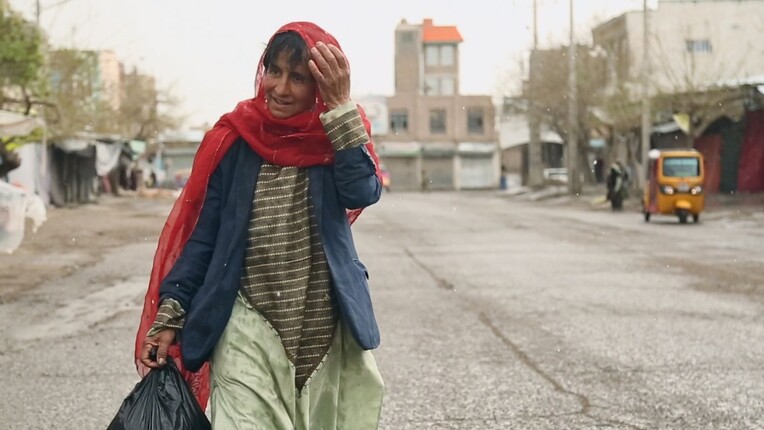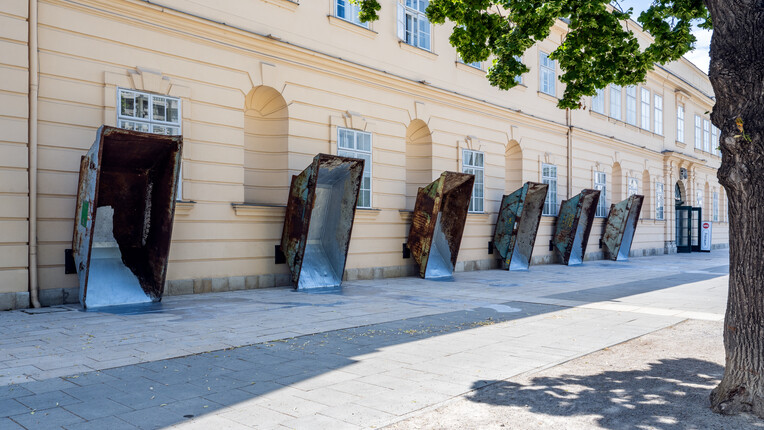![[Translate to English:] [Translate to English:] Amanda Barbourin roter Strickjacke vor einer grünen Wand, die orange Qs zeigt](/fileadmin/_processed_/e/0/csm_amanda-barbour_c4989c403b.jpg)
"You don’t need to abide by the rules of convention in order to create something valuable."
Film theorist, art critic and former Artist-in-Residence Amanda Barbour talks about feminism and film, as well as her experiences at this year's TRICKY WOMEN / TRICKY REALITIES festival.
This year’s TRICKY WOMEN / TRICKY REALITIES festival was cut short due to the Covid-19 pandemic and out of consideration for the health and safety of all participants. Amanda Barbour, film theorist, art critic and artistic director of the intersectional feminist film festival FEM&IST Films in Melbourne, was invited as Artist-in-Residence in March to cultivate nuanced discussions around the festival. Her residency at the MQ was also interrupted by the pandemic and she had to leave Vienna earlier than planned in order to be able to enter Australia before the borders closed. Now she has to stay in quarantine for two weeks.
Amanda, how are you? And what is the situation like where you are now?
Quarantine is actually quite nice, but it took a bit of mental work for me to come to that conclusion. My time in Vienna was wild because every hour of every day galleries were closing, borders were closing, flights were being cancelled. It felt like I was watching this unfold on live stream, which is disturbing, because the problem is that this doesn’t end with Covid-19. Climate change is a fertile environment for new diseases to propagate, and Australia only recently stopped being on fire.
There are a lot of perfectly valid reasons to be depressed right now, but I rewatched The Marriage of Maria Braun (Rainer Werner Fassbinder, 1978) and Party Girl (Nicholas Ray, 1958) the night before I flew home. These films are set in the aftermath of the Second World War and during the Great Depression, respectively. But they both feature badass women who make the best out of a bad situation; highlights include Cyd Charisse fighting off a gangster with a hairbrush and Hanna Schygulla telling the American army to fuck off in two languages. The way I thought about the pandemic changed after revisiting these films, because I figured if these women could figure something out, then so can I.
The situation more generally, in Australia, is as strange as it seems to be elsewhere. People have started spitting on each other when they’re freaked out and frustrated, which is an interesting weaponization of plasma, but obviously very rude as well. Then it was announced today that there will be a national limit on how much alcohol we can buy: 12 bottles of wine and 48 beers per person per day. It’s a hilariously bizarre policy. Meanwhile in Canberra, we have the English-speaking world’s first Pentecostal prime minister. The Pentecostal Church is a branch of Evangelical Christianity that believes in speaking in tongues and end times, which may explain our government’s slow reaction to Covid-19 and complete inaction on climate change.
I think I like quarantine because I’m isolated from other people.
During the TRICKY WOMEN / TRICKY REALITIES festival, you conducted interviews with directors and animation film artists. Who or what most impressed you at this year’s festival as long as it lasted?
I mean, a lot of the artist talks that we had planned were cancelled due to galleries and cinemas closing down at extremely short notice. The festival was a really chaotic time for this reason. I did enjoy interviewing Shinobu Soejima though.
Why?
We both have a research-heavy approach to our work and I suspect we both think about death a lot, the dialectics of life and death. Approaching it as this liminal space which is both a site of endless possibility and evaporating potential.
You also gave a lecture at the Austrian Film Museum on “Animation as Tool to Destroy the Patriarchy” – can you sum up how to do that?
I think the key thing in terms of the “how” is letting go of the pressure to make sense, or present something palatable that audiences can understand within the frameworks of conventional storytelling. Convention is dictated by the dominant culture and the dominant culture is patriarchal. What we learn in school, from politics to philosophy, is primarily the musings of white, heterosexual men. Their tools of expression and frameworks within which they understand reality are informed by their lived experience, and this experience is normally different from that of marginalized groups (whether they be gay men, black men, women, transgender people etc.). My point was that in creating any kind of art you don’t need to abide by the rules of convention in order to create something valuable. You can watch the lecture here:
You are the Artistic Director of the intersectional feminist film festival FEM&IST Films in Australia, can you talk about your work there – is it comparable to Tricky Women?
Not really, Tricky Women is a medium-specific festival that platforms non-male creatives. Our focus at FEM&IST Films is more on the politics a film presents, and how that relates to empowerment in marginalized communities. Our most recent event was on Indigenous leadership and climate change. While we normally platform women, gender is one of many dimensions when we’re talking about questions of power.
In terms of our programming directives, we believe that self-determination leads to better storytelling. So if we show a film about women in Syria, we’ll want that film to be made by a Syrian woman. We don’t have any conditions related to genre or film form; so we’ve screened animation, documentary, surrealism and featured things like slam poetry after screenings instead of the traditional Q&A format.
What is your ideal feminist film?
Something that expands the bounds of what we thought was possible.
What does feminism mean to you? The term triggers quite different associations and polarizes – on the one hand some women refuse to call themselves “feminist” and actually consider it as a swearword (e.g. Austria’s Federal Minister for Women and Integration, Susanne Raab, thinks that “feminism separates women more than it unites them”) and on the other hand “feminist” is printed on T-shirts, socks, monetized and commercialized.
In my mind, feminism is just believing in equality and exploring how gender can propagate inequalities. I don’t think you need to identify as a feminist to embody incredibly feminist action, most of our mothers don’t identify as feminists, yet they taught us how to stand up for ourselves and demand fair treatment. I look at people’s actions more than what’s written on their T-shirts, because, as you say, words carry different meanings to different people.
Since you are also a translator and not only work with visuals but also a lot with text, who is your favorite philosopher / “intellectual” / theorist and why?
I’ll answer your question backwards. The “why” of what I like is that I’ve always been interested in asymmetrical power dynamics, so I like things that speak to that but can present a side that I hadn’t considered before. For example, I’ve always been pro-choice when it comes to women’s reproductive rights. But I had never considered the bio-political implications of restricted access to abortion and the logic that allows those policies to eventuate until I read Dr Maria Teresa Galarza’s doctoral thesis: “Dissenting fiction re-righting law: practice-led research into biopolitics, women’s rights and reproductive justice in Ecuador”.
Other texts that I’ve enjoyed recently include Michael Mackenzie’s From Athens to Berlin: The 1936 Olympics and Leni Riefenstahl’s Olympia and Willow Catelyn Maclay’s The Size of Your Love: The Psychological Effects of Violence in the Horror Films of Rob Zombie. All of the texts that I’ve listed here are available online for free, but an upcoming release with a price tag that I’ve been looking forward to is Ana Hedberg Olenina’s Psychomotor Aesthetics: Movement and Affect in Modern Literature and Film.
What is your favorite film of all times?
I have no idea, different films are good for different reasons and it’s hard for me to reduce that to one title that speaks to all connotations of excellence.
Taking into account that the César for best director went to Roman Polanski, as well as the Literature Nobel Prize to Peter Handke - do you think that one can separate the artist from their work?
Irrespective of predatory behavior, in art criticism you always need to consider both creator and context, because this gives audiences a more wholistic understanding of the work in question. Picasso is well known for painting his lovers, that’s why they’re always crying. It would be ludicrous to ignore the fact that The Weeping Woman (1937) is Dora Maar, because that information gives you more insight into the oil on canvas and the man who painted it. I haven’t seen Roman Polanski’s J’accuse (2019), but a pedophile in exile making a film called “I accuse” tells you everything you need to know. Polanski identifies with Alfred Dreyfus and sees himself as wrongfully persecuted. The jury at the César’s condoned this when they awarded it French cinema’s highest honor. I haven’t read any of Peter Handke’s works, but a quick Google tells me he’s a fan of Slobodan Milošević and his accolades are not well received by Muslims in South Eastern Europe. Again, it’s a question of why Milošević would appeal to an Austrian novelist? How does that affinity inform his works? If his works are indeed praiseworthy, why? Juries need to be honest with themselves when deciding merit, because there’s no basis in logic for spontaneously ignoring context when it becomes inconvenient. Or rather, when it makes a juror or a critic ashamed of their aesthetic preferences.
Thank you, Amanda!
TRICKY WOMEN / TRICKY REALITIES Statement, March 2020:
Parallel to the Tricky Women/Tricky Realities festival, the world changed fundamentally within three days. After months of preparation, Tricky Women/Tricky Realities could not proceed as originally planned. This was out of consideration for the health of the artists, the audience, the guests and the team. Especially as the entire free art scene is confronted with existential challenges, it is important for us to pay tribute to the creative works of female animation-film artists. Thus, against all odds, we screened the competition programs, and the jury still decided on the awards. We would like to thank everyone who participated and who supported us. On this note, we would also like to express our thanks for the many supportive and positive words that have reached us during recent days!
Interview: Esther Brandl
